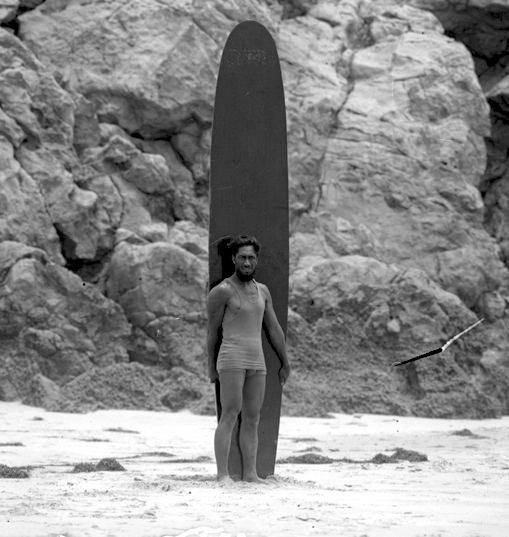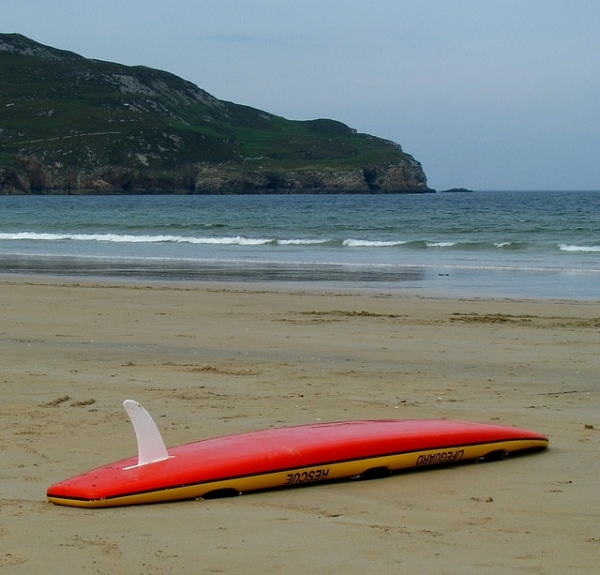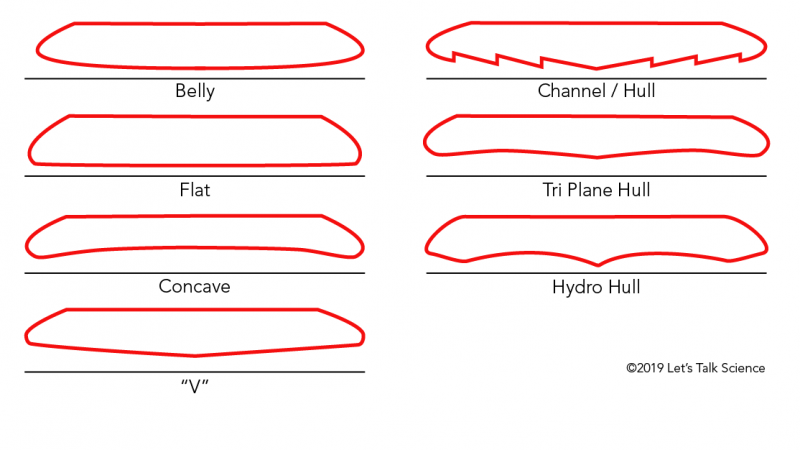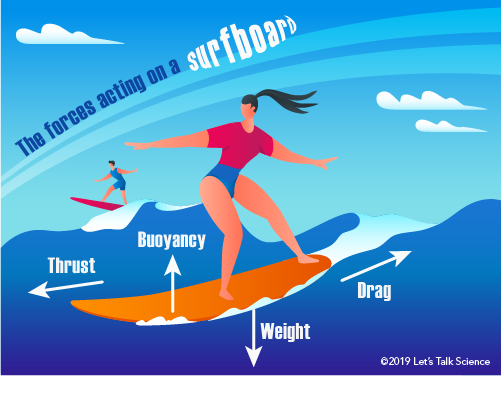The Physics of Surfing

Cartoon woman surfing (Source: Let’s Talk Science)

Cartoon woman surfing (Source: Let’s Talk Science)
How does this align with my curriculum?
| Grade | Course | Topic |
|---|
Learn about the history of surfboards, and how different materials and designs over the years affected the physics at work in surfing.
Every time you play or do a sport, there’s physics at work. Surfing is no exception!
Surfing is a great example of how buoyancy, surface tension, mass, shape and hydrodynamic forces can act together to give surfers the perfect ride. Mass and shape relate to the body of the surfers themselves. But buoyancy and hydrodynamic forces relate to the surfboard.
How has surfboard design changed over the years?
Before the 1920s, surfboards were heavy and huge. They could weigh about 45 kg (ca. 99 lb) and could be up to 5 m (ca. 16 ft) long!

Surfboards used to be made of wood from Redwood trees. Redwood is not a very water-resistant material. As the surfer surfed, the surfboard would absorb (soak in) water. The surfboard would gradually get heavier.
But in 1926, an American surfer named Tom Blake had an idea. He drilled holes into his surfboard. This removed a lot of wood, which made these heavy boards much, much lighter. Blake then covered the top and bottom of the holes with a thin layer of wood veneer. This design was a huge hit. The world’s first mass-produced surfboard was born!
From then on, people began improving surfboards. In 1932, manufacturers began producing balsa wood surfboards. These surfboards weighed much less, usually about 14 kg (ca. 31 lb). A few years later, manufacturers began adding fixed tail fins. These fins made surfboards more stable. They also made the surfboards easier to steer. The fins helped surfers achieve the right balance of thrust and drag.

Surfboard technology stayed the same for decades. But in the 1950s, manufacturers began producing foam and fibreglass surfboards. These surfboards were lighter and stronger than their wooden ancestors.
These new materials were also more hydrodynamic. Hydrodynamics is the study of forces acting on, or exerted by, fluids. It also deals with solids immersed in fluids, like a surfboard immersed in water, for example.
The shape of both the surfboard and its fin change the way the water moves around it. They also affect the surfer’s ability to control the surfboard in the water.
Varying the shape of the underside of the surfboard will give the surfer a different kind of ride. For example:
- Double-concave boards give a smoother ride
- V-bottom boards turn easily

Surfboard designers actually use a lot of the same principles as rocket science does. For example, the surfboard company Varial Surf was started by a former SpaceX engineer. Their surfboards are made from the same materials as rockets! The company has even created a new, more buoyant type of foam. This foam crystallizes, which forms tightly packed cells. This means more cells can be packed into the same area, making these surfboards lighter and stronger.
What are the physics of surfing?
When you surf, there are several forces at work. The forces of gravity and buoyancy are working against each other. Gravity is pulling the surfboard down. Buoyancy is pushing it up. Which force is greater? It depends on the density of the surfboard’s materials. As you can guess, the materials used in surfboards today are much lighter and less dense than the wooden materials used in the past. Surfboards are also less dense overall than water. This is what allows them to float in the first place!
Of course, the body of the surfer adds weight. Weight is equal to mass times the force of gravity (9.8 m/s2). If a surfer sat perfectly still on a surfboard in the water, that surfboard would likely begin to sink. Keeping a low center of gravity is one of the most important techniques to be a good surfer. To remain balanced and stable, surfers crouch, keeping their center of gravity low. Surfers can also change their position on the board. If a surfer stands in the middle of the board where buoyancy and weight are balanced, the board will be flat. If the surfer moves back, the nose of the board will go up, making it easier to steer.

Meanwhile, drag from the water creates friction in the opposite direction a surfer is moving in. This helps the surfer control the surfboard’s movement.
So how do you use physics to catch a wave? When you are lying on a surfboard, waiting to catch a wave, you are at rest. But when you see a wave approaching, you begin to paddle your arms so that you can move towards it. You accelerate until your velocity is the same as the velocity of the wave. At this point, gravity, buoyancy, thrust and drag are in perfect balance.
Starting Points
- Have you surfed? If so, what was it like? If not, would you like to try surfing? Why/why not?
- Have you ever been snowboarding? Do you think it has some similarities to surfing? How so?
- How has our scientific understanding of buoyancy and density affected the development of surfboard technology? Explain.
- Should innovations for surfboards be regulated by governments or sports associations to help prevent cheating by competitive surfers? Explain.
- Do you think surfboard designers should consider how the boards might lead to an increase in surfing injuries and possible dangers to aquatic animals? Why/why not?
- Do you think the technology used in designing surfboards could also be used to create faster and safer modes of transportation? Explain.
- How have surfboards changed over the years to improve on speed and performance?
- What are the four major forces acting on a surfboard riding a wave?
- How does the material, size, and type/shape of fins make a surfboard more hydrodynamic?
- How is surfing similar to canoeing?
- How is snowboarding similar to surfing?
- Science and technology have been used to improve performance in different sports. Is this an appropriate way to use scientific knowledge? Why/why not?
- What advances in technology have influenced the design and construction of surfboards? Conduct research to find out how surfboard technology has developed changed from its origins to the present.
- When you see surfers in the media, they are often portrayed as underachievers with no knowledge of science or technology. Do you think this is accurate? Why/why not?
- Movies usually reflect the technology available for the period they are representing. Have you ever watched an older surfer movie? What have you noticed about the design and style of surfboards used in the film?
- This video and article can be used to support teaching and learning of Physics, History & World Studies and Technology & Engineering related to buoyancy, manufacturing and wood (materials). Concepts introduced include surfing, surfboards, absorb, manufacturers, fixed-tail fins, stable, thrust, drag, hydrodynamics, engineers, forces, gravity, buoyancy, weight, mass, force of gravity, drag, accelerate and velocity.
- Teachers could use this video to introduce the topic of buoyancy and/or the applications of buoyancy. Prior to showing the video teachers could activate prior knowledge by asking students if they have ever been on a surfboard or small boat such as a canoe or kayak. What challenges did they face? Did they fall into the water? How long did it take them to be able to move the vessel easily and safely? If they haven’t used one of these vessels before, what do they think would be the most difficult thing about using them?
- Before watching the video and reading the article, teachers could provide students with a Vocabulary Preview to activate prior knowledge and introduce new terminology. Download ready-to-use reproducibles using the Vocabulary Preview learning strategy for this video in [Google doc] and [PDF] formats.
- To help consolidate learning, teachers could then engage students in a think-pair-share activity. Ask students to think about different ways that science is involved in water sports such as surfing and boating and then to share their thinking with a partner. Groups could then be invited to share their thinking with the class. Group leaders or the teacher could record students’ ideas.
- To further consolidate learning, teachers could have students draw and label diagrams showing the forces and directions of the forces acting on a surfer riding a surfboard.
- For design and technology focus, teachers could have students conduct research on the changes in surfboard design, including the technologies that influenced its design and construction throughout history. To summarize their research students could create a timeline of surfboard design and technology.
Connecting and Relating
- Have you surfed? If so, what was it like? If not, would you like to try surfing? Why/why not?
- Have you ever been snowboarding? Do you think it has some similarities to surfing? How so?
Relating Science and Technology to Society and the Environment
- How has our scientific understanding of buoyancy and density affected the development of surfboard technology? Explain.
- Should innovations for surfboards be regulated by governments or sports associations to help prevent cheating by competitive surfers? Explain.
- Do you think surfboard designers should consider how the boards might lead to an increase in surfing injuries and possible dangers to aquatic animals? Why/why not?
- Do you think the technology used in designing surfboards could also be used to create faster and safer modes of transportation? Explain.
Exploring Concepts
- How have surfboards changed over the years to improve on speed and performance?
- What are the four major forces acting on a surfboard riding a wave?
- How does the material, size, and type/shape of fins make a surfboard more hydrodynamic?
- How is surfing similar to canoeing?
- How is snowboarding similar to surfing?
Nature of Science/Nature of Technology
- Science and technology have been used to improve performance in different sports. Is this an appropriate way to use scientific knowledge? Why/why not?
- What advances in technology have influenced the design and construction of surfboards? Conduct research to find out how surfboard technology has developed changed from its origins to the present.
Media Literacy
- When you see surfers in the media, they are often portrayed as underachievers with no knowledge of science or technology. Do you think this is accurate? Why/why not?
- Movies usually reflect the technology available for the period they are representing. Have you ever watched an older surfer movie? What have you noticed about the design and style of surfboards used in the film?
Teaching Suggestions
- This video and article can be used to support teaching and learning of Physics, History & World Studies and Technology & Engineering related to buoyancy, manufacturing and wood (materials). Concepts introduced include surfing, surfboards, absorb, manufacturers, fixed-tail fins, stable, thrust, drag, hydrodynamics, engineers, forces, gravity, buoyancy, weight, mass, force of gravity, drag, accelerate and velocity.
- Teachers could use this video to introduce the topic of buoyancy and/or the applications of buoyancy. Prior to showing the video teachers could activate prior knowledge by asking students if they have ever been on a surfboard or small boat such as a canoe or kayak. What challenges did they face? Did they fall into the water? How long did it take them to be able to move the vessel easily and safely? If they haven’t used one of these vessels before, what do they think would be the most difficult thing about using them?
- Before watching the video and reading the article, teachers could provide students with a Vocabulary Preview to activate prior knowledge and introduce new terminology. Download ready-to-use reproducibles using the Vocabulary Preview learning strategy for this video in [Google doc] and [PDF] formats.
- To help consolidate learning, teachers could then engage students in a think-pair-share activity. Ask students to think about different ways that science is involved in water sports such as surfing and boating and then to share their thinking with a partner. Groups could then be invited to share their thinking with the class. Group leaders or the teacher could record students’ ideas.
- To further consolidate learning, teachers could have students draw and label diagrams showing the forces and directions of the forces acting on a surfer riding a surfboard.
- For design and technology focus, teachers could have students conduct research on the changes in surfboard design, including the technologies that influenced its design and construction throughout history. To summarize their research students could create a timeline of surfboard design and technology.
Learn more
A short Ted-Ed video (4:40 min.) by Nick Pizzo explains the physics of surfing.
Tracy V. Wilson gives a short overview of the laws of physics at play in surfing.
Article by Chris Woodford asks what are waves, and how do you surf them?
A surfer and a scientist teamed up to create the perfect wave
This video (3:05 min.) from Science Magazine shows artificial wave conditions created at an experiment surf ranch.
References
California Surf Museum. (n.d.). Who invented the foam surfboard.
Trinastic, J. (2017, October 17). Waves of physics: The science of surfing. Science Connected Magazine.